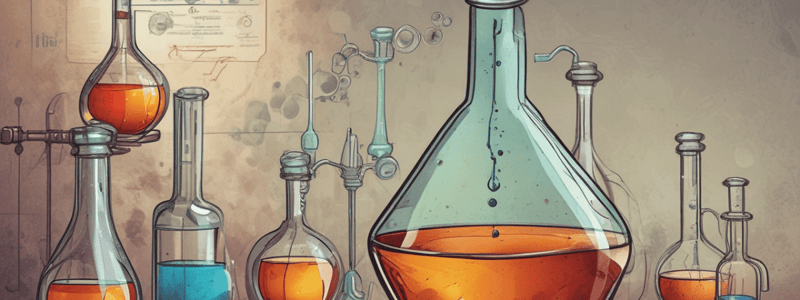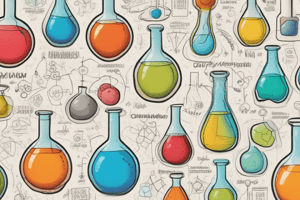Podcast
Questions and Answers
What is a primary use of ethanol in the chemical industry?
What is a primary use of ethanol in the chemical industry?
- In the production of formaldehyde
- As a fuel in bioethanol (correct)
- As an antiseptic
- As a solvent
What is the characteristic that allows alcohols to engage in hydrogen bonding?
What is the characteristic that allows alcohols to engage in hydrogen bonding?
- The presence of a hydroxyl group (correct)
- The presence of a thiol group
- The presence of a phenol group
- The presence of a methyl group
What is a common use of thiols in biological systems?
What is a common use of thiols in biological systems?
- As fuels
- As antiseptics
- As solvents
- In the synthesis of proteins and other biomolecules (correct)
Why do alcohols have higher boiling points than do ethers and alkanes of similar molar masses?
Why do alcohols have higher boiling points than do ethers and alkanes of similar molar masses?
What is a common use of phenols in various industries?
What is a common use of phenols in various industries?
How are alcohols classified?
How are alcohols classified?
What is the characteristic feature of phenols?
What is the characteristic feature of phenols?
What is the primary method of preparing alcohols?
What is the primary method of preparing alcohols?
What is the result of oxidizing a primary alcohol?
What is the result of oxidizing a primary alcohol?
What is the purpose of the Rast method in the identification of alcohols?
What is the purpose of the Rast method in the identification of alcohols?
What is the focus of recent research in organic chemistry?
What is the focus of recent research in organic chemistry?
What is the reaction known as the Friedel-Crafts acylation?
What is the reaction known as the Friedel-Crafts acylation?
What is the characteristic feature of thiols?
What is the characteristic feature of thiols?
What is the result of the Sandmeyer reaction?
What is the result of the Sandmeyer reaction?
What is the purpose of the Bein-Stecher method in the identification of thiols?
What is the purpose of the Bein-Stecher method in the identification of thiols?
What is the role of glycerol in biological systems?
What is the role of glycerol in biological systems?
What is the primary reason for the higher boiling points of alcohols compared to ethers and alkanes of similar molar masses?
What is the primary reason for the higher boiling points of alcohols compared to ethers and alkanes of similar molar masses?
Which of the following methods is NOT commonly used for preparing alcohols?
Which of the following methods is NOT commonly used for preparing alcohols?
What is the main difference between the IUPAC nomenclature of alcohols and phenols?
What is the main difference between the IUPAC nomenclature of alcohols and phenols?
Which of the following is a common reaction involving alcohols?
Which of the following is a common reaction involving alcohols?
What is the primary method used for identifying alcohols?
What is the primary method used for identifying alcohols?
What is a common application of alcohols in the chemical industry?
What is a common application of alcohols in the chemical industry?
Which of the following is a characteristic property of alcohols?
Which of the following is a characteristic property of alcohols?
What is a common method of preparing alcohols?
What is a common method of preparing alcohols?
Which of the following reactions is commonly used to identify alcohols?
Which of the following reactions is commonly used to identify alcohols?
What is a common reaction involving alcohols?
What is a common reaction involving alcohols?
Study Notes
Alcohols, Phenols, and Thiols: Applications, Properties, Preparation, Reactions, Identification, and Research
Alcohols, phenols, and thiols are a group of organic compounds that play a significant role in various applications, especially in the chemical industry. These compounds have unique properties, preparation methods, reactions, and identification techniques, which are essential for their understanding and utilization. This article provides a detailed overview of these compounds within the context of their applications, properties, preparation, reactions, identification, and recent research.
Applications
Alcohols, phenols, and thiols have a wide range of applications in various industries. Alcohols are used as solvents, fuels, and in the production of various chemicals. Ethanol, for example, is widely used as a fuel in bioethanol, and methanol is used in the production of formaldehyde and acetic acid. Phenols are used as antiseptics and disinfectants, while thiols are essential components of biological systems, particularly in the synthesis of proteins and other biomolecules.
Properties
Alcohols are compounds in which a hydroxyl group (OH) is attached to a carbon atom. They are classified according to the number of carbon atoms attached to the carbon atom that is attached to the OH group. Alcohols have higher boiling points than do ethers and alkanes of similar molar masses due to their ability to engage in hydrogen bonding. Phenols are compounds in which an OH group is attached directly to an aromatic ring, and many phenols are used as antiseptics. Thiols, also known as mercaptans, are compounds in which a hydrogen atom is replaced by a sulfur atom. Thiols are common in biological compounds and play a crucial role in biological systems.
Preparation
Alcohols can be prepared by the hydration of alkenes, ethanol being an example. Ethanol can also be produced by the fermentation of sugars or starch from various sources. Phenols are prepared by the halogenation of aromatic compounds followed by the addition of hydroxide ions. Thiols are prepared by the reaction of an alkyl halide with a sulfur nucleophile, such as hydrogen sulfide.
Reactions
Alcohols can be dehydrated to form either alkenes or ethers, depending on the reaction conditions. Primary alcohols are oxidized to form aldehydes, while secondary alcohols are oxidized to form ketones. Tertiary alcohols are not readily oxidized. Glycols are alcohols with two OH groups on adjacent carbon atoms, and glycerol is the most important trihydroxy alcohol.
Phenols can undergo Friedel-Crafts acylation, where an acyl chloride reacts with a phenol to form an acylated phenol. They can also undergo the Sandmeyer reaction, where a nitro group is replaced by a phenol. Thiols can undergo various reactions, including the Michael addition, where a thiol reacts with an electrophile to form a thioether. They can also undergo the Bohlmann-Rahtz reaction, where a thiol reacts with an alkene to form a cyclic thioether.
Identification
Alcohols, phenols, and thiols can be identified using various techniques. For alcohols, the Rast method involves the reaction of an alcohol with a silver salt to form a silver oxide precipitate. For phenols, the Rast-Zscheischang method involves the reaction of a phenol with a silver salt and a mineral acid to form a red precipitate. For thiols, the Bein-Stecher method involves the reaction of a thiol with hydrogen peroxide and a silver salt to form a black precipitate.
Recent Research
Recent research has focused on the development of efficient methods for the direct construction of sulfenic ester derivatives from thiols and alcohols, as well as the fabrication of sulfonic esters. These areas have been identified as crucial for the advancement of organic chemistry and the development of new synthetic methods. Additionally, there is a growing interest in the use of green solvents and catalysts in the acetylation of alcohols, amines, phenols, and thiols, as well as the use of ultrasound and ruthenium(III) chloride for the acetylation of these compounds.
In conclusion, alcohols, phenols, and thiols are essential compounds with a wide range of applications in various industries. Their unique properties, preparation methods, reactions, and identification techniques are crucial for their understanding and utilization. Recent research has focused on the development of new synthetic methods, green solvents, and catalysts for the acetylation of these compounds, which will continue to drive the advancement of organic chemistry.
Studying That Suits You
Use AI to generate personalized quizzes and flashcards to suit your learning preferences.
Description
Learn about the properties, preparation methods, reactions, and applications of alcohols, phenols, and thiols in organic chemistry, as well as recent research in this area. Understand the importance of these compounds in various industries and their role in biological systems.




